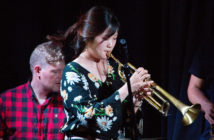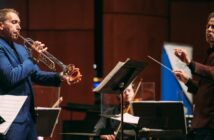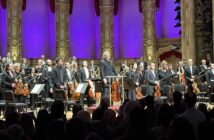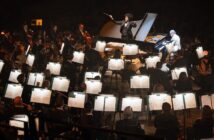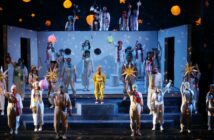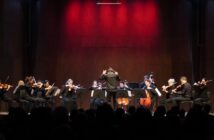The Festival international de jazz de Montréal (FIJM) just marked its 40th annual edition and was more than ready to pull out all stops. Its success over the years has been ensured in a marketing strategy geared towards greater commercialism, as mirrored in its across-the-board programming that, yes, still has jazz in it (the bulk of which is in concert halls rather than on the stages of its Disneyland outdoor site). Of the many ways it thought of celebrating its milestone year, it decided to include another banner-year celebrant, the world-renowned Munich-based imprint ECM Records. Founded in 1969, this label has amassed an incredible catalogue of over 1600 titles, with close to 40 new additions this year alone. As one of its three co-founders, the classically trained bassist Manfred Eicher has been its main producer over the years. Not long after setting up shop, in the early 1970s, he decided to cast his instrument aside to devote himself fully to the cause of others, and has thus written about as many musical pages of musical history as releases for his Edition of Contemporary Music.
For anyone versed in jazz, the label needs no introduction. In classical music, it has carved a niche of its own, launching its New Series in 1984. Whatever music graces its discs, it is unfailingly branded with that “ECM sound” qualifier. That attribute, however, has distorted to some degree the overall picture in that it shifts the focus away from the content to the product itself. Granted, its album designs and recording/mixing standards cannot be overlooked or overheard, but close listening leads one to conclude that there is no single ECM aesthetic, but many. After all, when stellar names like Keith Jarrett, Roscoe Mitchell, Paul Bley, Evan Parker, Dave Holland or Egberto Gismonti bolster its jazz catalogue, it invalidates the claim that it is a one-size-fits-all label.
In this, its 50th year of operations, the label has been showcased at several events, starting with the Winter Jazz Fest in New York followed by the Big Ears festival in Knoxville, and more to come till year’s end (most notably the two-night celebration at Lincoln Center next Nov. 1 and 2). Add to that list the one series that just occurred in Montreal.
For the last 30 years, the FIJM has always included an Invitation Series in its program, which in most cases was divided equally between two artists per year, each one asked to perform in various settings of their choice, at times suggested by its main programmer, the now retiring André Ménard. While not without precedent, the invitation extended to a label has been an exceptional occurrence. But when considering ECM’s broad musical scope, it would have been impossible to embrace it all in just five concerts. Yet, the choices were quite revealing, less of the label, but more of the programmer’s musical tastes.
Thurs. 28, 6 p.m. – Vijay Iyer and Craig Taborn
Keyword: Generous – On the strengths of their debut release in the New Year, both pianists are very much talked about these days. There is much good to say about long-standing musical associations, theirs ongoing since 2010. This is particularly true when players engage without benefit of any safety nets, i.e. composed music or established set lists. While they may allude to a piece or another according to their whims, they just go for it, and through-improvise. Their opening night festival performance was indeed generous, maybe even to a fault, in that they played two lengthy blocks of about 40 minutes each, and another good ten minutes after that. Between the first and second part, they even switched pianos, which they do at times. Before the show, Taborn indicated that the two Steinways were very different in tone quality, hence the decision to switch half way. The finale stretched things out a little too much for this reviewer, whereas the sudden simultaneous end on a ringing chord in the second part seemed like the perfect closer, one that even brought the audience to its feet, and rightfully so.
Read feature article on this duo here.
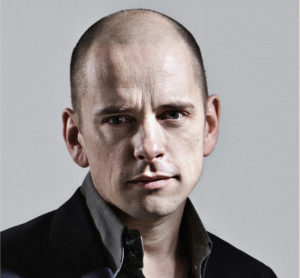 Fri. 29, 6 p.m. – Tord Gustavsen Trio
Fri. 29, 6 p.m. – Tord Gustavsen Trio
Keyword: Transparent – If there is one thread running through a host of ECM productions, it is the one often designated by that almost cliched-term “Nordic Sound”. From its first protagonists like Jan Garbarek, Bobo Stenson (see below), Jon Christensen and Palle Danielssen, generations of successors have since been spawned, Ketil Bjørnstad, Jon Balke and Trygve Seim to name a few. Yet another of those cool torch bearers from those upper longitudes is the Norwegian pianist Tord Gustavsen. True to his recordings, his performance was a model of that aesthetic, the music devoid of knotty harmonies or slippery lines, unfolding with deliberation over an airy pulse. On two occasions, the pianist moved the tempo up, and like most players from those lands, he resorted to some very bluesy lines with gospel-like overtones (may it have something to do with the plagal cadences it shares with the folk-hymns of those countries?…) With standby drummer Jarle Vesperstadt, the trio was rounded out that evening by Gjermund Silseth, subbing for regular Sigurd Hole. In his one feature, a solo intro to one number, the stand-in bassist delivered a masterful bowed solo that sung in the cello range. Also of note were two Bach-inspired pieces bookending the concert and a Leonard Cohen cover (I Came so Far for Beauty). If it were not for the fact that the Montreal bard would be the one person whose music Gustavsen would like to devote a record to some day, as per his own admission, the playing of that one piece may well have come across as a bit of pandering before a hometown audience.
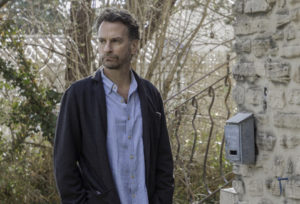 Thurs. July 4, 10:30 p.m. – Larry Grenadier, solo
Thurs. July 4, 10:30 p.m. – Larry Grenadier, solo
Keyword: Eloquent – In a festival of such magnitude geared at filling halls (and coffers), presenting a solo double bass concert was not an obvious way of going about it. Because of a recent album (The Gleaners), Larry Grenadier currently enjoys the necessary exposure to be offered a gig at the festival. But as a stalwart accompanist of Brad Mehldau and several visits to the festival over the years, he came to the city very much a known quantity. In the ideally suited Gesù Theatre, he delivered an hour-long recital consisting of mostly original music, ending on two smartly combined covers by Powell and Monk. Of interest was his retuning of the strings for certain pieces, which created an array of timbral shades, some in the viola range, especially in one number he said was influenced by Hindemith (a violist himself). Also convincing was his bowing, often a blind spot for jazz bassists, and in one place he even plucked a string while bowing. Nowhere did the concert lag, with each piece lasting long enough to sustain interest. Clearly, this was a music well worked out from start to finish, which does not mean that it was tightly scripted like a written score, yet Grenadier was in clear control of the music, which is how good concerts should be.
Fri. July 5, 6:00 p.m. – Bobo Stenson solo
Keyword: Serene – At a month shy of his 75th anniversary, Swedish pianist Bo Gustav Stenson is now at the twilight of a career that spans more than half a century and all but the first year of ECM’s own history. Appearing on over 25 albums for the label, not to forget a host of others, the Swedish pianist is a man who has all the wherewithall to carry him through a solo concert. Like a vessel sailing on gently stirring waters, he set out on a journey of his own making, dropping an anchor in spots to lift it and move on until landing back in port, safe and sound. For a musician of his reputation, the turnout was somewhat disappointing, and that may well be explained by the issuing of his latest release over a year ago, a reminder of how quickly recordings appear and fade from the radar screen.
 Fri. July 5, 10:30 p.m. – Nik Bärtsch’s Ronin
Fri. July 5, 10:30 p.m. – Nik Bärtsch’s Ronin
Keyword: Lofty – First, an admission: I have never been a fan of this Swiss pianist and his quartet. Up until this performance, my knowledge was on record alone. An acquaintance, however, encouraged me to check them out live, which he believed was a far better way to hear them. An afternoon conversation with the pianist was surely informative, learning about his background, influences and modus operandi for all of the music he devises for his band. But the proof of the pudding, as they say, is in the eating, or hearing in this case. For the uninitiated, his music is so rigorously structured and notated that it seems hardly possible for anyone to add something to it, or extemporize, as, say, a jazz soloist would. Essentially, his music is built on by rhythmical patterns and grooves that make it turn more like a machine than allowing it to breathe like a living organism. It is as if a high precision clock were at work here (lest we forget, he is Swiss), the beats ticking away inexorably with no escape hatches to slip out of. While it is impressive that his group can deliver all of this without any music in front of them – and a book of compositions for sale on the table in the lobby was proof of its demanding nature – one fact remains: it is not the band that makes the music, (at least to these ears) but the other way around. More pointedly, Bärtsch’s vision is more singular than varied because of its cast-in-stone parameters. Seen that way, Ronin is not post-modern but more modern in intent, closer to the aims of post-World War II contemporary music or to the American minimalists of the 1960s (Young, Glass, Reich). And if need be to label it, its music could best be called contemporary music locked in complex grooves. In contrast, today’s jazz is more post-modern than ever, and given the facts it has always strived for a more supple rhythmic flow and greater personal input from band leaders and sidemen alike, it would difficult to establish a connection of any sort between the jazz tradition and its current state of affairs on the one hand, and the very concepts that govern the mindset of this Swiss pianist and his associates on the other.
One final note The FIJM awards annually a series of prizes, one of these (a.k.a. The Bruce Lundvall Prize) to an important contributor to the music business. This year’s awardee was, you guessed it, Manfred Eicher. Though he declined the invitation to accept it in person, it was apparently worked out to have Bobo Stenson pick it up in his name in a ceremony before his concert. Sadly, this never happened, but worse, Mr. Stenson himself was left in the lurch, with no one of the festival ever contacting him in that regard and he leaving the next day empty handed. Now that’s what Prez used to call a Von Hangman.
Reviewed by Marc Chénard, visuals courtesy of ECM Photo credits (by order of appearance): M.J. Frisell, H.F. Asbjørnsen, J. Hitters, D. Váss and J. Holthaus.
More festival reviews (in French) – Women in jazz (4 views)– Jeu de Dames




